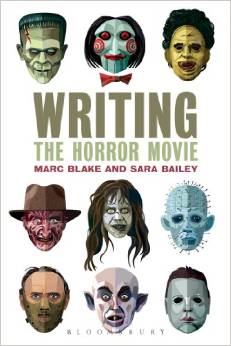| Marc Blake and Sara Bailey, Writing the Horror Movie. New York and London: Bloomsbury, 2013. ISBN 9781441196187 US $18.99 (hb) 272pp (Review copy supplied by Bloomsbury Publishing) |
 |
The front cover of Writing the Horror Movie reminded this reader of Roy Ward Baker’s horror-comedy The Monster Club (1980). Specifically, I recalled the undead family tree that appeared as a backdrop throughout that film. This family tree was explained in gloriously theatrical fashion by a vampiric Vincent Price. Alas, the frontispiece (and the celluloid memories that it evoked) are amongst the few highlights of Writing the Horror Movie. Marc Blake and Sara Bailey show considerable enthusiasm for the horror genre. Alas, enthusiasm does not always equal quality.
The aim of the text is ostensibly to explore the various facets of the horror film screenplay. Blake and Bailey describe the strands of horror that have circulated throughout pop culture history. These include “psychological”, “supernatural” and “body horror”. The authors analyse horror movie tropes, and provide case studies of assorted movie monsters. These monsters include Michael Vorhees (of the Halloween franchise) and the intellectual cannibal in The Silence of the Lambs (1991), Dr Hannibal Lecter. There are analyses of novel-to-film adaptations, and a discussion of horror film festivals.
Blake and Bailey draw examples from an impressive range of horror movies. However, theirs is not an academic text per se, and hence it lacks the sense of scholarly detachment that characterises much academic writing. That’s fine, but this reader bristled at lines such as: “Robin Hardy’s Wicker Man [UK 1973] is the best British folk horror bar none” (34). The problem with subjective statements such as these is that many readers will not agree with them; indeed, some might vehemently disagree. (My own biases come into play here: Hardy’s film has always been vastly overrated.)
The most compelling parts of Writing the Horror Movie feature interviews with writers of contemporary horror films. These writers include Christopher Smith (of Creep, 2004) and Victor Miller (of the Friday the 13th franchise). The interviews give readers a sense of the appeal which horror films hold for some screenwriters, and of the conventions and ideas drawn upon. Puzzlingly, the interviews are (mostly) relegated to discrete chapters; a more nuanced idea would have been to thread excerpts from these interviews throughout, to buttress the authors’ points. Indeed, the key problem with this book is that the very issue of writing tends to get sidelined. Blake and Bailey provide more of a broad overview of horror cinema, though this overview is riddled with errors that even a quick Google search would have rectified. For example, The Silence of the Lambs (1991) is not a remake of Manhunter (1986) (68). Dracula’s Daughter (1936) is not a product of Hammer Studios (114). (Perhaps the authors were thinking of 1971’s Countess Dracula? Though that film does not engage at all with the Dracula myth.) And Young Frankenstein (1974) was not released in 1960 (115).
The above errors might be embarrassing, but the prose is little better. Some passages are corny, for example: “Mankind has always been fascinated by what comes after life …” (22). Others are rather odd, for example: “That your child is not really your child but a destructive foreign agent is a dread all Parents will know, and the idea your offspring [sic] is simply evil is one that will occur on more than one sleepless night.” (27)
I don’t have children, but number of my friends do. These friends discuss anxieties about their offspring, and none of these anxieties involve the kids developing rotating heads and spewing slime à la Linda Blair in The Exorcist (1973). Matters get worse when Blake and Bailey write: “Only someone mentally disturbed would believe that they could have any power over, or make any kind of contract with, [the devil]” (27). The implication here seems to be that those living with mental illness are most prone to Satan worship. This is beyond offensive.
Elsewhere, the authors make provocative statements that they fail to adequately think through, with disastrous consequences. For example: “It is no accident that many hauntings and ghost sightings have female or young protagonists, as it is generally held that women and the young are more in tune with their psyche.”
The sexism and also the fantasy of youthful innocence that underpin this statement go curiously unremarked. The authors also declare that “Terror is horror’s orgasm” (49), and they mention “torture porn” (101), as well as films such as Hostel (2005). This could have segued into an analysis of the relationship between horror and pornography, but such an analysis is not forthcoming. The words orgasm and porn have been included because they are attention-grabbers.
Writing the Horror Movie might provide joy for some devout horror aficionados. Readers searching for a more sophisticated and accurate perspective on the horror genre are advised to look elsewhere.
